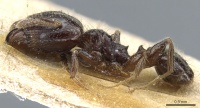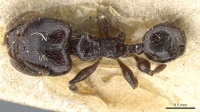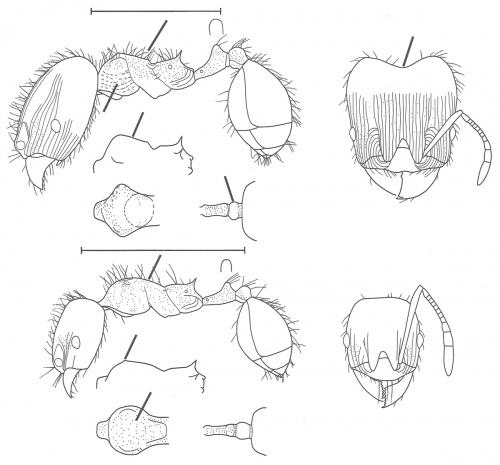Pheidole nigella
| Pheidole nigella | |
|---|---|

| |
| Scientific classification | |
| Kingdom: | Animalia |
| Phylum: | Arthropoda |
| Class: | Insecta |
| Order: | Hymenoptera |
| Family: | Formicidae |
| Subfamily: | Myrmicinae |
| Tribe: | Attini |
| Genus: | Pheidole |
| Species: | P. nigella |
| Binomial name | |
| Pheidole nigella Emery, 1894 | |
| Synonyms | |
| |
Nothing is known about the biology of nigella.
Identification
See the description in the nomenclature section.
Keys including this Species
Distribution
Known from Bolivia and Peru. (Wilson 2003)
Latitudinal Distribution Pattern
Latitudinal Range: -14.79861111° to -31.632389°.
| North Temperate |
North Subtropical |
Tropical | South Subtropical |
South Temperate |
- Source: AntMaps
Distribution based on Regional Taxon Lists
Neotropical Region: Bolivia (type locality), Peru.
Distribution based on AntMaps
Distribution based on AntWeb specimens
Check data from AntWeb
Countries Occupied
| Number of countries occupied by this species based on AntWiki Regional Taxon Lists. In general, fewer countries occupied indicates a narrower range, while more countries indicates a more widespread species. |

|
Estimated Abundance
| Relative abundance based on number of AntMaps records per species (this species within the purple bar). Fewer records (to the left) indicates a less abundant/encountered species while more records (to the right) indicates more abundant/encountered species. |

|
Biology
Castes
Worker
Minor
Images from AntWeb
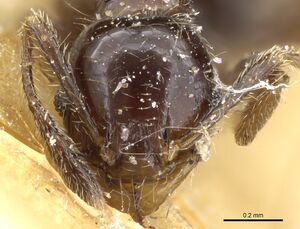 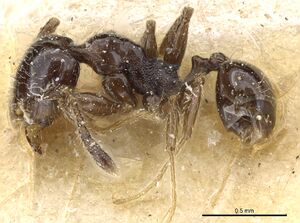 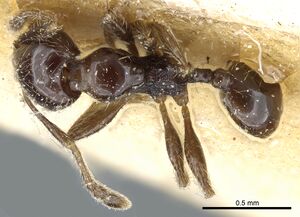 
| |
| Paralectotype of Pheidole fabricator nigella. Worker. Specimen code casent0904380. Photographer Z. Lieberman, uploaded by California Academy of Sciences. | Owned by MSNG, Genoa, Italy. |
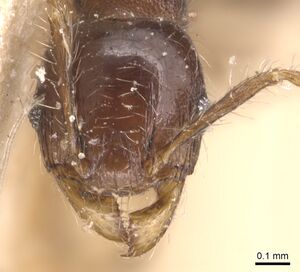 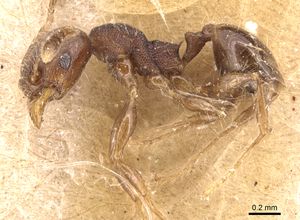 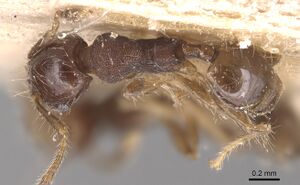 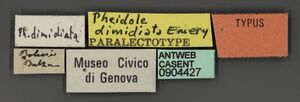
| |
| Paralectotype of Pheidole dimidiata. Worker. Specimen code casent0904427. Photographer Will Ericson, uploaded by California Academy of Sciences. | Owned by MSNG, Genoa, Italy. |
Major
Images from AntWeb
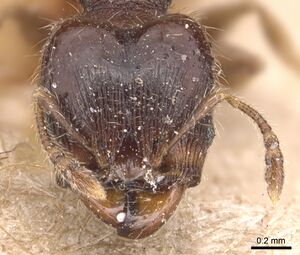 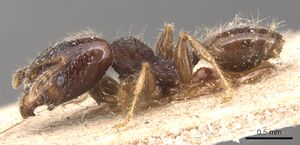 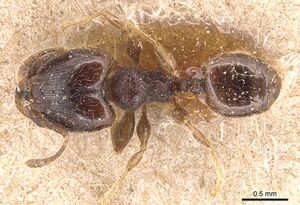 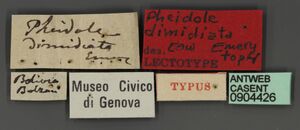
| |
| Lectotype of Pheidole dimidiata. Worker (major/soldier). Specimen code casent0904426. Photographer Will Ericson, uploaded by California Academy of Sciences. | Owned by MSNG, Genoa, Italy. |
Nomenclature
The following information is derived from Barry Bolton's Online Catalogue of the Ants of the World.
- dimidiata. Pheidole dimidiata Emery, 1894c: 160 (s.w.) BOLIVIA. Junior synonym of nigella: Wilson, 2003: 728.
- nigella. Pheidole fabricator var. nigella Emery, 1894c: 155 (s.w.) BOLIVIA. Raised to species and senior synonym of dimidiata: Wilson, 2003: 728.
Unless otherwise noted the text for the remainder of this section is reported from the publication that includes the original description.
Description
From Wilson (2003): DIAGNOSIS A member of the tristis group similar to Pheidole balzani, Pheidole fabricator and Pheidole tristis, and distinguished from these and other species in the group by the following traits.
Major: small and dark; occiput with very broad, moderately deep median occipital concavity in full-face view; humerus in dorsaloblique view a low, smooth convexity that runs almost indistinguishably into the mesothorax; mesothoracic convexity extremely reduced, barely visible; postpetiolar node oval; weak longitudinal carinulae cover sides of pro no tum.
Minor: humerus with low blunt denticle in dorsal-oblique view; pronotum and mesonotum indistinguishable in a single profile; mesonotal convexity absent.
MEASUREMENTS (mm) Major (nigella lectotype): HW 1.06, HL 1.10, SL 0.60, EL 0.14, PW 0.50. Minor: HW 0.54, HL 0.60, SL 0.54, EL 0.10, PW 0.38.
COLOR Major and minor: body concolorous medium brown, appendages brownish yellow.
Figure. Upper: major (syntype of synonymous P. dimidiata Emery). Lower: minor (syntype of synonymous P. dimidiata Emery). BOLIVIA: Salinas, Rio Beni, Bolivia; Luigi Balzan. Scale bars = 1 mm.
Type Material
Salinas, Rio Beni, Bolivia, col. Luigi Balzan. Museo Civico di Storia Naturale, Genoa - as reported in Wilson (2003)
Etymology
L nigella, little dark one. (Wilson 2003)
References
- Emery, C. 1894d. Studi sulle formiche della fauna neotropica. VI-XVI. Bull. Soc. Entomol. Ital. 26: 137-241 (page 155, soldier, worker described)
- Wilson, E. O. 2003. Pheidole in the New World: A dominant, hyperdiverse ant genus. Cambridge, Mass.: Harvard University Press, [ix] + 794 pp.: 794pp (page 728, fig. major, minor describe, Raised to species: new status, Senior synonym of dimidiata)
References based on Global Ant Biodiversity Informatics
- Bezdeckova K., P. Bedecka, and I. Machar. 2015. A checklist of the ants (Hymenoptera: Formicidae) of Peru. Zootaxa 4020 (1): 101–133.
- Cuezzo, F. 1998. Formicidae. Chapter 42 in Morrone J.J., and S. Coscaron (dirs) Biodiversidad de artropodos argentinos: una perspectiva biotaxonomica Ediciones Sur, La Plata. Pages 452-462.
- Emery C. 1894. Studi sulle formiche della fauna neotropica. VI-XVI. Bullettino della Società Entomologica Italiana 26: 137-241.
- Fernández, F. and S. Sendoya. 2004. Lista de las hormigas neotropicales. Biota Colombiana Volume 5, Number 1.
- Kempf, W.W. 1972. Catalago abreviado das formigas da regiao Neotropical (Hym. Formicidae) Studia Entomologica 15(1-4).
- Kusnezov N. 1953. La fauna mirmecológica de Bolivia. Folia Universitaria. Cochabamba 6: 211-229.
- Piva A., and A. E. de C. Campos. 2012. Ant Community Structure (Hymenoptera: Formicidae) in Two Neighborhoods with Different Urban Profiles in the City of Sao Paulo, Brazil. Psyche 2012 (390748): 1-8
- Santschi F. 1925. Fourmis des provinces argentines de Santa Fe, Catamarca, Santa Cruz, Córdoba et Los Andes. Comunicaciones del Museo Nacional de Historia Natural "Bernardino Rivadavia" 2: 149-168.
- Vittar, F. 2008. Hormigas (Hymenoptera: Formicidae) de la Mesopotamia Argentina. INSUGEO Miscelania 17(2):447-466
- Vittar, F., and F. Cuezzo. "Hormigas (Hymenoptera: Formicidae) de la provincia de Santa Fe, Argentina." Revista de la Sociedad Entomológica Argentina (versión On-line ISSN 1851-7471) 67, no. 1-2 (2008).
- Wheeler W. M. 1925. Neotropical ants in the collections of the Royal Museum of Stockholm. Arkiv för Zoologi 17A(8): 1-55.
